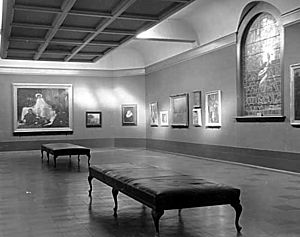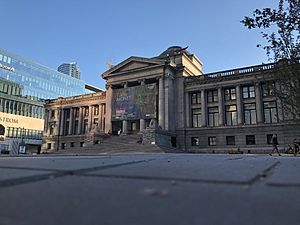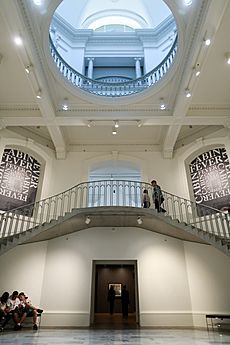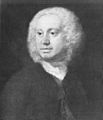Vancouver Art Gallery facts for kids
 |
|
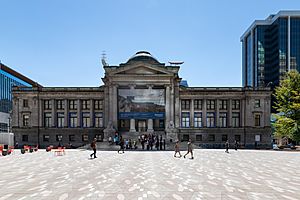
The front of the Vancouver Art Gallery building.
|
|
| Established | April 1931 |
|---|---|
| Location | 750 Hornby Street, Vancouver, British Columbia, Canada |
| Type | Art museum |
| Visitors | 305,421 (2020) |
The Vancouver Art Gallery (VAG) is a famous art museum in Vancouver, British Columbia, Canada. It is located in a large, 15,300-square-metre-building (165,000 sq ft) next to Robson Square in the city's downtown area. This makes it the biggest art museum in Western Canada based on its size.
The beautiful building was designed by architect Francis Rattenbury. It was first used as a provincial courthouse. In the early 1980s, it was transformed into the art gallery we know today. Because of its history, the building was named a National Historic Site of Canada in 1980.
The gallery's collection holds about 12,000 artworks. These pieces were created by artists from Canada and all over the world. The museum shows art from its own collection and also hosts special exhibitions that travel from other museums.
Contents
History of the Gallery
Early Years
The Vancouver Art Gallery first opened on October 5, 1931. Its original home was a smaller building on West Georgia Street. This building was designed by the architectural firm Sharp and Johnston. It had four galleries, a lecture hall, and a library. At first, most of the art shown was by British and other European artists.
In 1938, a group of unemployed protesters held a sitdown strike inside the museum. They stayed in the building for several weeks, but luckily, none of the paintings were damaged.
In 1950, the museum was renovated. The outside of the building was changed to a more modern International Style. The changes were also made to create space for 157 artworks given to the museum by the famous artist Emily Carr. The gallery reopened in 1951.
A New Home
By the 1980s, the gallery needed more space. In 1983, it moved to its current location: the old provincial courthouse. The Government of British Columbia still owns the building, but the museum has a long-term agreement to use it.
Before the gallery moved in, the building was renovated by architect Arthur Erickson. This cost about CA$20 million. The renovation was part of a bigger project to redevelop the entire Robson Square area.
In 2015, the gallery bought 10 oil sketches believed to be by J. E. H. MacDonald, a famous Canadian artist. However, people soon questioned if they were real. After a long investigation, it was discovered that the sketches were fakes.
Plans for the Future
For many years, the gallery has been planning to move to an even bigger, brand-new building. The new location was planned for a spot called Larwill Park.
The famous architectural firm Herzog & de Meuron was chosen to design the new building. However, the project faced delays because of rising costs. The estimated cost grew from $400 million to $600 million. In December 2024, the gallery announced that it had cancelled the proposed design and removed the architects from the project. The gallery is now looking at new options for its future.
The Gallery Building
The museum is housed in a grand building that looks like it could be from ancient Greece or Rome. This style is called Neoclassical. It was designed by Francis Rattenbury and opened in 1911 as a courthouse.
The building features large ionic columns, a central dome, and detailed stonework. The marble used to build it was brought from Alaska, Tennessee, and Vermont. When it was a courthouse, it had 18 courtrooms.
A famous feature of the building is two large lion statues made of granite. They were placed at the entrance in 1910. In 1942, during World War II, someone set off dynamite that damaged the back of one of the lions. Many people thought the city was under attack! The same stonecutters who originally carved the lions were hired to repair the damage. If you look closely, you can still see the line where the new piece was joined.
A Place for People to Gather
The steps and lawn in front of the art gallery are a popular spot for public events in Vancouver. People gather there for protests, rallies, and fun events like the Zombie Walk.
In 2007, a countdown clock for the 2010 Winter Olympics was placed on the lawn. After the games, the clock was taken apart.
In June 2021, a memorial was created on the gallery's steps. It honored the children whose remains were discovered at the Kamloops Indian Residential School. The memorial featured 215 pairs of shoes, one for each child.
The Permanent Collection
The Vancouver Art Gallery's permanent collection includes about 12,000 artworks. The collection is owned by the City of Vancouver, and the museum takes care of it. The gallery focuses on collecting art from British Columbia, especially historical and modern art from the Lower Mainland area.
About half of the works in the collection are by artists from Western Canada. The gallery also has a strong focus on art by First Nations artists and artists from Asia.
The collection includes many photographs and conceptual art (art where the idea is more important than the object). It features works by famous international artists like Andreas Gursky and Cindy Sherman, as well as photographers from the Vancouver School.
Famous Canadian Art
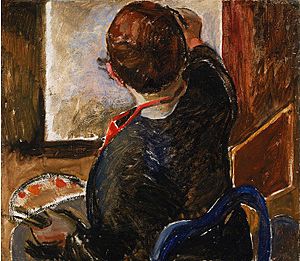
The museum has a large collection of art by Canadian artists. This includes members of the famous Group of Seven.
It is especially known for its collection of works by Emily Carr, one of British Columbia's most important artists. The gallery has over 250 of her pieces. One of her paintings, Totem Poles, Kitseukla, was one of the very first works the museum ever acquired.
The museum also has a significant collection of Indigenous Canadian art. It includes works by artists from many First Nations, including Haida, Kwakwakaʼwakw, and Nuu-chah-nulth. The collection features totem poles, carvings, and drawings by well-known artists like Bill Reid and Robert Davidson.
Selected Works from the Collection
-
William Hogarth, Portrait of Mr. Bridgeman, c. 1725–1730
-
Joseph Wright of Derby, The Captive from Sterne, 1774
-
Emily Carr, Path among Pines, c. 1930
Special Exhibitions and Programs
The Vancouver Art Gallery hosts many temporary exhibitions throughout the year. These shows often feature famous artists from around the world. Some popular past exhibitions have included works by Leonardo da Vinci, Claude Monet, Pablo Picasso, and Takashi Murakami.
The gallery also offers many public programs. These include live music, dance performances, artist talks, and lectures by art experts. These events give visitors a chance to learn more about art and connect with artists.
See also
 In Spanish: Galería de Arte de Vancouver para niños
In Spanish: Galería de Arte de Vancouver para niños
- List of art museums
- List of museums in British Columbia


